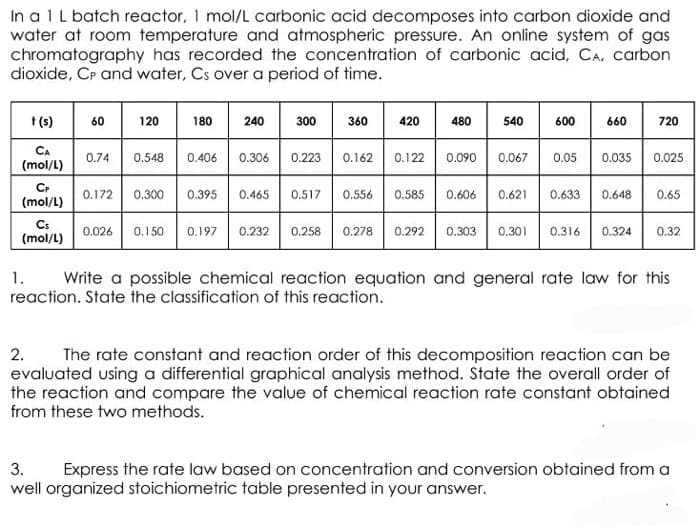In a 1 L batch reactor, 1 mol/L carbonic acid decomposes into carbon dioxide and water at room temperature and atmospheric pressure. An online system of gas chromatography has recorded the concentration of carbonic acid, CA, carbon dioxide, CP and water, Cs over a period of time.
In a 1 L batch reactor, 1 mol/L carbonic acid decomposes into carbon dioxide and water at room temperature and atmospheric pressure. An online system of gas chromatography has recorded the concentration of carbonic acid, CA, carbon dioxide, CP and water, Cs over a period of time.
Introduction to Chemical Engineering Thermodynamics
8th Edition
ISBN:9781259696527
Author:J.M. Smith Termodinamica en ingenieria quimica, Hendrick C Van Ness, Michael Abbott, Mark Swihart
Publisher:J.M. Smith Termodinamica en ingenieria quimica, Hendrick C Van Ness, Michael Abbott, Mark Swihart
Chapter1: Introduction
Section: Chapter Questions
Problem 1.1P
Related questions
Question

Transcribed Image Text:In a 1 L batch reactor, 1 mol/L carbonic acid decomposes into carbon dioxide and
water at room temperature and atmospheric pressure. An online system of gas
chromatography has recorded the concentration of carbonic acid, CA, carbon
dioxide, CP and water, Cs over a period of time.
+ (5) 60
CA
(mol/L)
CP
(mol/L)
Cs
(mol/L)
120
0.74 0.548
180
0.026 0.15
0.406
240 0 300 360
0.306
0.223
0.162
0.172 0.300 0.395 0.465 0.517 0.556
0.258 0.27
420
0.122
480 540 600 660
0.090 0.067 0.05 0.035 0.025
0.585 0.606 0.621
720
0.292 0.3
0.633 0.648 0.65
0.301 0.316 0.324 0.32
1. Write a possible chemical reaction equation and general rate law for this
reaction. State the classification of this reaction.
2. The rate constant and reaction order of this decomposition reaction can be
evaluated using a differential graphical analysis method. State the overall order of
the reaction and compare the value of chemical reaction rate constant obtained
from these two methods.
3. Express the rate law based on concentration and conversion obtained from a
well organized stoichiometric table presented in your answer.
Expert Solution
This question has been solved!
Explore an expertly crafted, step-by-step solution for a thorough understanding of key concepts.
This is a popular solution!
Trending now
This is a popular solution!
Step by step
Solved in 5 steps with 14 images

Recommended textbooks for you

Introduction to Chemical Engineering Thermodynami…
Chemical Engineering
ISBN:
9781259696527
Author:
J.M. Smith Termodinamica en ingenieria quimica, Hendrick C Van Ness, Michael Abbott, Mark Swihart
Publisher:
McGraw-Hill Education

Elementary Principles of Chemical Processes, Bind…
Chemical Engineering
ISBN:
9781118431221
Author:
Richard M. Felder, Ronald W. Rousseau, Lisa G. Bullard
Publisher:
WILEY

Elements of Chemical Reaction Engineering (5th Ed…
Chemical Engineering
ISBN:
9780133887518
Author:
H. Scott Fogler
Publisher:
Prentice Hall

Introduction to Chemical Engineering Thermodynami…
Chemical Engineering
ISBN:
9781259696527
Author:
J.M. Smith Termodinamica en ingenieria quimica, Hendrick C Van Ness, Michael Abbott, Mark Swihart
Publisher:
McGraw-Hill Education

Elementary Principles of Chemical Processes, Bind…
Chemical Engineering
ISBN:
9781118431221
Author:
Richard M. Felder, Ronald W. Rousseau, Lisa G. Bullard
Publisher:
WILEY

Elements of Chemical Reaction Engineering (5th Ed…
Chemical Engineering
ISBN:
9780133887518
Author:
H. Scott Fogler
Publisher:
Prentice Hall


Industrial Plastics: Theory and Applications
Chemical Engineering
ISBN:
9781285061238
Author:
Lokensgard, Erik
Publisher:
Delmar Cengage Learning

Unit Operations of Chemical Engineering
Chemical Engineering
ISBN:
9780072848236
Author:
Warren McCabe, Julian C. Smith, Peter Harriott
Publisher:
McGraw-Hill Companies, The